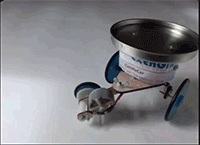
I’ve been fascinated by Stirling and other heat based engines as long as I can remember, which is why I’m excited to announce that these educational alternative energy kits from Exergia are now available in the Maker Shed. These unique kits are assembled using simple hand tools and come with clear English and German instructions. They also have some clever packaging; each comes inside a small can which is later re-used in the build (for most of the kits.)
The Stirling Engine Kit is great for demonstrating principles of thermodynamics and is powered by a small tea-light candle (or your wood burner, provided it isn’t too hot.) If you’ve ever built a Stirling engine, you probably know that they can be a bit finicky. The above engine took me about an hour to assemble and ran the first time I lit the candle and spun the prop.
The Candle Car Kit uses the same principal that powers nuclear space probes (the Seebeck effect.) Instead of using decaying radioactive material and the cold of space, however, the car uses candle and a heat sink. After you build the car, put it on a smooth surface and fill the reservoir with water. Light the included candle and after a minute or so, the resulting temperature deferential across a Peltier junction will produce enough energy to drive the motor. You can increase the speed of the car by using colder water or adding ice cubes, and have it go straight or in circles by adjusting the front wheel.
The Thermogenerator 2.0 also demonstrates the Seebeck effect for power generation. Just build the kit and fill one side of the reservoir with cold water, and the other with hot. The Peltier junction sandwiched between the two aluminum plates will generate enough electricity to turn the prop with just a 10 degree difference. Increasing the temperature differential by using hotter water or ice will increase the speed of the propeller.
This one boggles my mind a bit. The Heatmobile 2.0 converts heat directly into mechanical energy using a continuous loop of Nitinol wire. Nitinol is a shape memory alloy (~50% Nickel, ~50% Titanium) which has the unique property of “remembering” a shape it was formed into at high temperature. When heated to its transition temperature by warm water the wire attempts to return to that shape. This force is enough to drive the propeller until the water cools below the transition temperature. The really interesting part is that this motor is bi-directional; spin the prop clockwise and it will continue clockwise. Spin it counter clockwise and it will continue counter clockwise.
These kits are perfect for tinkerers, students, or anyone interested in alternative energy. Check them all out in the Maker Shed online store.
ADVERTISEMENT









